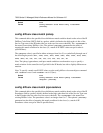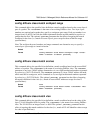
7000 Series L3 Managed Switch Reference Manual for Software v2.0
CLI Commands: Differentiated Services 9-15
Note: The policy type dictates which of the individual policy attribute commands are valid within
the policy definition.
Format config diffserv policy create <policyname> <in/out>
config diffserv policy delete
This command eliminates an existing DiffServ policy. The <policyname> parameter is the name
of an existing DiffServ policy. This command may be issued at any time; if the policy is currently
referenced by one or more interface service attachments, this deletion attempt shall fail.
Format config diffserv policy delete <policyname>
config diffserv policy rename
This command changes the name of a DiffServ policy. The <policyname> is the name of an
existing DiffServ class. The
<newpolicyname> parameter is a case-sensitive alphanumeric string
from 1 to 31 characters uniquely identifying the policy.
Format config diffserv policy rename <policyname> <newpoli-
cyname>
config diffserv policy class add
This command creates an instance of a class definition within the specified policy for the purpose
of defining treatment of the traffic class through subsequent policy attribute statements. The
<policyname> and <classname> are the names of an existing DiffServ policy and class,
respectively. Note that this command causes the specified policy to create a reference to the class
definition.
Format config diffserv policy class add <policyname> <class-
name>
config diffserv policy class remove
This command deletes the instance of a particular class and its defined treatment from the
specified policy. The
<policyname> and <classname> are the names of an existing DiffServ
policy and class, respectively. Note that this command removes the reference to the class definition
for the specified policy.


















